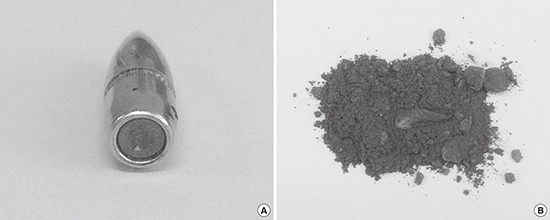1. Song Y, Suh C, Kim SA, Kim N, Kim SM, Jeong SW, Kim SY, Kim KH, Kim JH, Son BC, et al. High lead exposure in two leaded bronze ingot foundry workers. Ann Occup Environ Med. 2014; 26:38.
2. Kim JH, Kim EA, Koh DH, Byun K, Ryu HW, Lee SG. Blood lead levels of Korean lead workers in 2003–2011. Ann Occup Environ Med. 2014; 26:30.
3. Ye HH, Jeong JU, Baek NJ, Choi CY, Jeon MJ, Sakong J. A case of lead poisoning due to a mixture of talisman ash. Ann Occup Environ Med. 2013; 25:37.
4. Park WJ, Lee SH, Lee SH, Yoon HS, Moon JD. Occupational lead exposure from indoor firing ranges in Korea. J Korean Med Sci. 2016; 31:497–501.
6. Occupational Safety and Health Administration (US). OSHA lead standards [Internet]. accessed on 24 July 2017. Available at
http://www.osha.gov/SLTC/lead.
8. Gidlow DA. Lead toxicity. Occup Med (Lond). 2015; 65:348–356.
9. Flora G, Gupta D, Tiwari A. Toxicity of lead: a review with recent updates. Interdiscip Toxicol. 2012; 5:47–58.
10. Kim NH, Hyun YY, Lee KB, Chang Y, Ryu S, Oh KH, Ahn C. Environmental heavy metal exposure and chronic kidney disease in the general population. J Korean Med Sci. 2015; 30:272–277.
11. Lewis R, Kosnett MJ. Metals. In : LaDou J, Harrison R, editors. Current Occupational & Environmental Medicine. 5th ed. New York, NY: McGraw-Hill;2014. p. 463–485.
12. Kim HC, Jang TW, Chae HJ, Choi WJ, Ha MN, Ye BJ, Kim BG, Jeon MJ, Kim SY, Hong YS. Evaluation and management of lead exposure. Ann Occup Environ Med. 2015; 27:30.
13. Fischbein A, Hu H. Occupational and environmental exposure to lead. In : Rom WN, Markowitz S, editors. Environmental and Occupational Medicine. 4th ed. Philadelphia, PA: Lippincott Williams & Wilkins;2006. p. 954–990.
14. Kim YS, Park JH, Hong JR, Gil HW, Yang JO, Lee EY, Hong SY. Influence of blood lead concentration on the nerve conduction velocity in patients with end-stage renal disease. J Korean Med Sci. 2006; 21:290–294.
15. D’souza HS, Dsouza SA, Menezes G, Venkatesh T. Diagnosis, evaluation, and treatment of lead poisoning in general population. Indian J Clin Biochem. 2011; 26:197–201.
16. Beaucham C, Page E, Alarcon WA, Calvert GM, Methner M, Schoonover TM; Centers for Disease Control and Prevention (CDC). Indoor firing ranges and elevated blood lead levels - United States, 2002–2013. MMWR Morb Mortal Wkly Rep. 2014; 63:347–351.
17. Centers for Disease Control and Prevention (CDC). Lead exposure from indoor firing ranges among students on shooting teams--Alaska, 2002–2004. MMWR Morb Mortal Wkly Rep. 2005; 54:577–579.
18. Valway SE, Martyny JW, Miller JR, Cook M, Mangione EJ. Lead absorption in indoor firing range users. Am J Public Health. 1989; 79:1029–1032.
19. Landrigan PJ, McKinney AS, Hopkins LC, Rhodes WW Jr, Price WA, Cox DH. Chronic lead absorption. Result of poor ventilation in an indoor pistol range. JAMA. 1975; 234:394–397.
20. Demmeler M, Nowak D, Schierl R. High blood lead levels in recreational indoor-shooters. Int Arch Occup Environ Health. 2009; 82:539–542.






